For the Swedish artist and designer Moki Cherry, there was no separation between life and work. As her motto went: “The stage as a home, and the home as a stage.”
In 1963, at the age of 20, she met the jazz musician Don Cherry, with whom she formed a decades-long domestic and creative partnership. Roving between Europe and the US, they developed a new approach to performance, taking concerts out of late-night jazz clubs and into galleries, schools and outdoor spaces. Moki, who trained as a fashion designer in Stockholm, produced album covers, costumes and tapestries that were used as environments for these events – all in her signature psychedelic style. The enterprise, which fused eastern and western cultural traditions, was branded “Organic Music Theatre”.
The Cherry kids, Neneh and Eagle-Eye (both themselves famous musicians), usually came along for the ride. At one point, at the Moderna Museet in Stockholm, the whole family set up camp in a geodesic dome, where they held daily music workshops for three months in the summer of 1971. Moki, a practising Buddhist, painted a mandala on the floor over several days. When they weren’t on tour, the couple opened their home – from the 1970s, a former schoolhouse in southern Sweden – as an educational and creative centre for musicians, artists and children. There, too, Moki found opportunities for personal expression: from colourful murals painted on the walls to the garden where she grew vegetables.
Don and Moki separated in the 1980s, but she continued living and working at the schoolhouse until her death in 2009 (she also kept a home and studio in New York). Her granddaughter, Neneh’s daughter Naima Karlsson, has happy memories of staying with Moki in Sweden each summer. “She would find ways to keep me entertained when I was small, and once I was a bit older, I would help in the studio, preparing for shows,” she says. Karlsson is now an administrator for the artist’s estate and director of the Cherry Archive, and has co-curated the Institute of Contemporary Arts’s career-spanning survey of Moki Cherry’s work.
The artist’s first solo exhibition in the UK, it centres on her eye-popping appliquéd textiles. They swarm with images of plants, animals, humans, gods and more abstract symbols – one recurring motif is the outline of an ear inside a double-winged heart – as well as lines of text. “We have tried to be creative with our approach to installing the tapestries, hanging them in the centre of the room to echo the three-dimensional performance environments where they were first shown,” says Karlsson.
Visitors will also encounter Moki’s experiments with other media, including painting, drawing, ceramics and collage. The show is a rare opportunity to view her “lightboxes” – lightbulbs placed in carved wooden boxes – which she began making while working as a set designer at the Apollo Theater in Harlem in the 1990s. And there is plenty of archival material in the display, too: press clippings, photographs and footage of events.
During her lifetime, Moki’s artistic contributions were overlooked by museums and galleries. “People didn’t think of her work as fine art – it was seen as craft,” Karlsson says. These days, though, “there’s much more interest in female artists, as well as textiles and ceramics and collaborative work. It connects to what many younger artists are doing now.”
That’s not to mention the appeal of being transported via her art to the hippyish utopia she dedicated her life to cultivating, where creativity in all its forms was given the space to flourish.
Fruitful pursuits: four works by Moki Cherry
Title unknown, 1968
The abstracted female figure at the centre of this composition is a recurring feature of Moki’s paintings. “I was my husband’s muse, companion and collaborator,“ she said. “At the same time, I did all the practical maintenance. I was never trained to be a female, so I survived by taking a creative attitude to daily life and chores.”
Not My Cup of Tea, 2006 (main image)
Moki worked with collage from the late 1990s to the 2000s, covering furniture, objects and walls with printed matter. She also made individual photo montages. “I find it a good vehicle to reflect the situation we are currently living and existing in,” she said. “It is a very interesting expedition, finding the images.”

Title unknown, 1971
Cherry’s creative use of textiles is rooted in her training as a fashion designer. “She apprenticed at an haute couture atelier, worked at a women’s coat manufacturer, took evening classes, and studied fashion and textiles at college,” says Naima Karlsson. This soft hanging sculpture was displayed in the dome where the Cherry family lived in summer 1971. It was subsequently hung at their family home.

Organic Music outdoor stage set, 1972
“Most American jazz musicians came to Europe in the 1960s to play, because it was hard for Black musicians to get opportunities to work in the US,” says Karlsson. “This outdoor stage for a concert in Italy shows how Moki used her textile artworks to create a mobile stage environment.”
Moki Cherry: Here and Now is at the Institute for Contemporary Arts, London, 31 May to 3 September.

